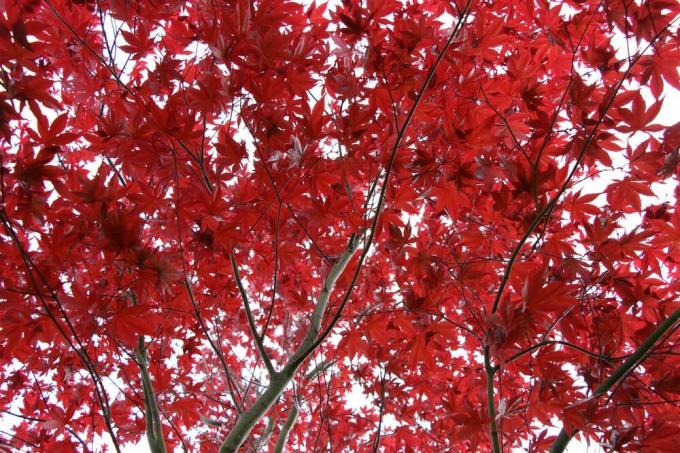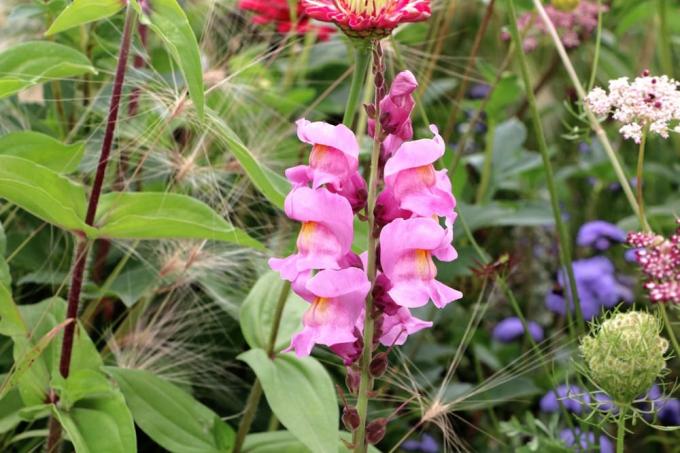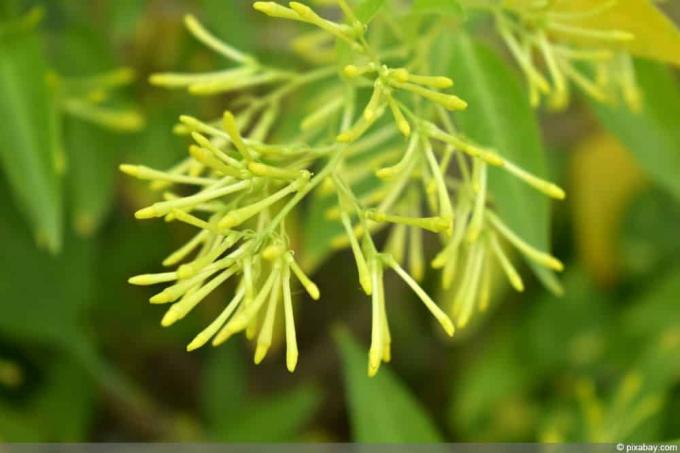

Table of contents
- Hardy Japanese Maple
- tub cultivation
- location in the garden
- Cultivation in the garden bed
- Pour
- Fertilize
Above all, the cultivation of the Japanese maple shows whether it needs to be protected in winter or not. Since it comes from the Japanese mountain regions, where there is a similar climate as in the local latitudes, it can overwinter well in the garden bed. If the tree was cultivated in a bucket, it should be protected. How it works with the right hibernation is explained here.
Hardy Japanese Maple
As a rule, the Japanese maple is hardy. Because he is used to the local temperatures, which also prevail in his homeland, the Japanese mountain regions in winter. In cultivation, little attention needs to be paid to winter protection. Older trees in particular can survive the winter without protection if the location is right. This should not be too damp, which means that a location that can dry off easily from the sun after rain or fog is recommended right from the start. In winter, you should pay attention to the following:
- avoid too much moisture
- Late frost can damage new leaf shoots
- Cover plant with fleece
- carefully so that no new shoots are injured
- mulch soil
Older trees from about the fourth to fifth year of life tolerate temperatures down to -10° Celsius in winter. If it gets colder, they should also be protected from the severe frost in winter.
Tip:
Instead of covering the plant with fleece, a frame made of light wooden slats can be built, to which the fleece is then attached all around. If necessary, i.e. on frosty nights, this can then be placed over the plant and thus protects it.
tub cultivation

Was the Japanese maple cultivated in a tub, since there is no garden, and the plant has a place on the balcony or terrace, then the roots in particular should be protected here, because more cold penetrates into a pot on frosty days a. A young maple in the bucket, on the other hand, should be protected overall. This should be done as follows:
- Spend tubs in a sheltered location
- covered corner on balcony or terrace
- Place buckets on wooden boards or styrofoam
- Mulch the soil thickly
- Wrap the pot with brushwood
- Cover the plant with plant fleece
- alternatively bring buckets to a frost-free place
- moderately bright and cool
- Cellar or garage well suited
- no boiler room, it's too warm here
A winter location in the house is not suitable, because since the Japanese maple sheds its leaves in autumn, it is not a pretty sight in the living rooms. It is also too warm in heated rooms. A bright stairwell, on the other hand, is also well suited for overwintering in a tub, as is an unheated conservatory.
Tip:
If the bucket has been moved to winter quarters, then the Japanese maple should slowly get used to warmer temperatures again. For this purpose, it can be brought outside on the first frost-free and sunny days in late winter. Do not place in direct sunlight for the first few days and put inside again at night.
location in the garden
Above all, you should pay attention to the right location in winter before planting. It shouldn't be too humid here. That means a spot right next to a large wall on the north side of a house is not suitable. An airy and slightly sunny location, even in winter, is better. The right winter location looks like this:
- semi-shady to slightly sunny
- airy
- nevertheless protected from easterly winds
- in an exposed garden bed
- on a meadow
- flanked by other trees
- no full shadow

If the Japanese maple gets too much sun in winter, there is a risk that the branches and trunk will burn. However, the plant can be protected from this with a plant fleece that is placed around the crown and trunk.
Tip:
If a Japanese maple is to be planted in spring, then the chosen location should be checked for suitability in the previous winter and a decision made if necessary.
Cultivation in the garden bed
If the Japanese maple was cultivated directly in the garden bed, then the young plant must always be protected here in winter. Because the young trees do not tolerate sub-zero temperatures. It is therefore always better to cultivate the plant in a bucket for the first few years and only place it in the desired location in the garden bed after four or five years. However, if the young maple was cultivated directly in the garden bed, the following measures should be taken before the onset of winter:
- Mulch the soil thickly
- alternatively or additionally put on brushwood slabs
- so no frost gets to the roots
- Wrap trunk with brushwood
- jute has also proven itself here
- protects against too much sun exposure
- cover the crown with fleece after the leaves have been shed
The plant fleece must be carefully removed again in spring before the new leaves sprout. In this way, the Japanese maple gets enough sunlight and warmth during the day to develop the new shoots. If there are night frosts here, they must also be protected and the plant must be wrapped in the fleece again overnight
Tip:
So that the temperatures in winter do not have to be constantly observed, it is also a good idea for older people Always protect Japanese maples to a certain extent in winter, for example the soil with mulch to cover
Pour

So that the Japanese maple does not dry up in winter, especially if it has been cultivated in a sunny garden bed, it must also receive moderate watering in winter. Potted plants that are no longer exposed to natural rain can also quickly suffer from drought damage in winter. Therefore, the following should be poured in the cold months:
- water only on frost-free days
- only when the soil is dry
- too much moisture is not tolerated in winter
- only during longer dry periods
- Do finger test on earth
- Don't forget buckets in winter quarters
- water moderately if necessary
- Avoid waterlogging
Tip:
In winter, it is better to water moderately in one day than to water too much at once. A second water supply can then take place a few days later.
Fertilize
From the end of August, beginning of September, the Japanese maple no longer needs to be fertilized. Since it sheds its leaves in autumn, not as many nutrients are needed. In addition, the mulch layer, which is placed on the earth to protect against the cold, also provides a supply of nutrients. The first fertilizers are then applied again in late winter, before the maple sprout again. Liquid fertilizer from the trade, which is given with the irrigation water, is suitable for potted plants. For garden plants, compost can be carefully placed underground in spring.
 garden editorial
garden editorial I write about everything that interests me in my garden.
Learn more about plant overwintering

Is the triplet flower hardy? 10 tips for wintering
The enchanting bougainvillea got its botanical name after its discoverer, the navigator Louis de Bougainville. On the Mediterranean Sea, it embellishes house facades. In Germany, where it is also known as a triplet, it is particularly popular as a container plant. How is it overwintered?

Overwintering poinsettia | Is he hardy?
The poinsettia belongs to the winter season like no other plant. But is it also a plant that is hardy or does it have special requirements when it comes to overwintering? The answers can be found at Hausgarten.net.

Is the snapdragon hardy? | 7 tips for overwintering snapdragons
The snapdragon is considered a classic among the ornamental flowers of the domestic plant bed. It blooms happily and handsomely over many Mondays. But is the snapdragon also hardy and how does the perennial overwinter? You will find the answer to these questions with us.

Ranunculus hibernate: this is how it works | Are ranunculus hardy?
Ranunculus is a beautiful flower, but it is only partially hardy in the local latitudes. Therefore, outdoors, the plant is dependent on warm protection in order to survive low frost temperatures without damage. Alternatively, you can overwinter the tubers in a frost-free place.

Night jasmine, Cestrum nocturnum - care and wintering
The night jasmine has developed into a popular container plant in this country. One reason for this is certainly its beautiful trumpet flowers, which unfold like a star. In order for this to work, however, it depends on the right location and care. More about this is here.

Overwintering lemon verbena from A-Z | Is Lemon Shrub Hardy?
One of the most refreshing scents in the home herb garden comes from lemon verbena. Growing them is worth it for that alone. Whether in a bed or in a bucket, it thrives everywhere in summer. Only the cold winter reveals its distant origin. What now?


